The HBK 2755 Smart Power Amplifier is a powerful, compact, and lightweight power amplifier with an integrated signal
generator and wireless remote-control capabilities.
The amplifier provides high-quality amplification and signal generation in a small, lightweight package,
and is available in two versions:
- HBK 2755: Includes Wi-Fi®, allowing you to configure and control the amplifier from a PC or mobile device when needed
- HBK 2755-A: Does not include Wi-Fi and is only operated by controls on the front panel
The amplifier has easy-to-access ports with calibrated dials and indicators to allow setups to be easily reproduced in future tests. The main functions are readily available upon power up, while additional functions and settings are accessible through a menu on the display.
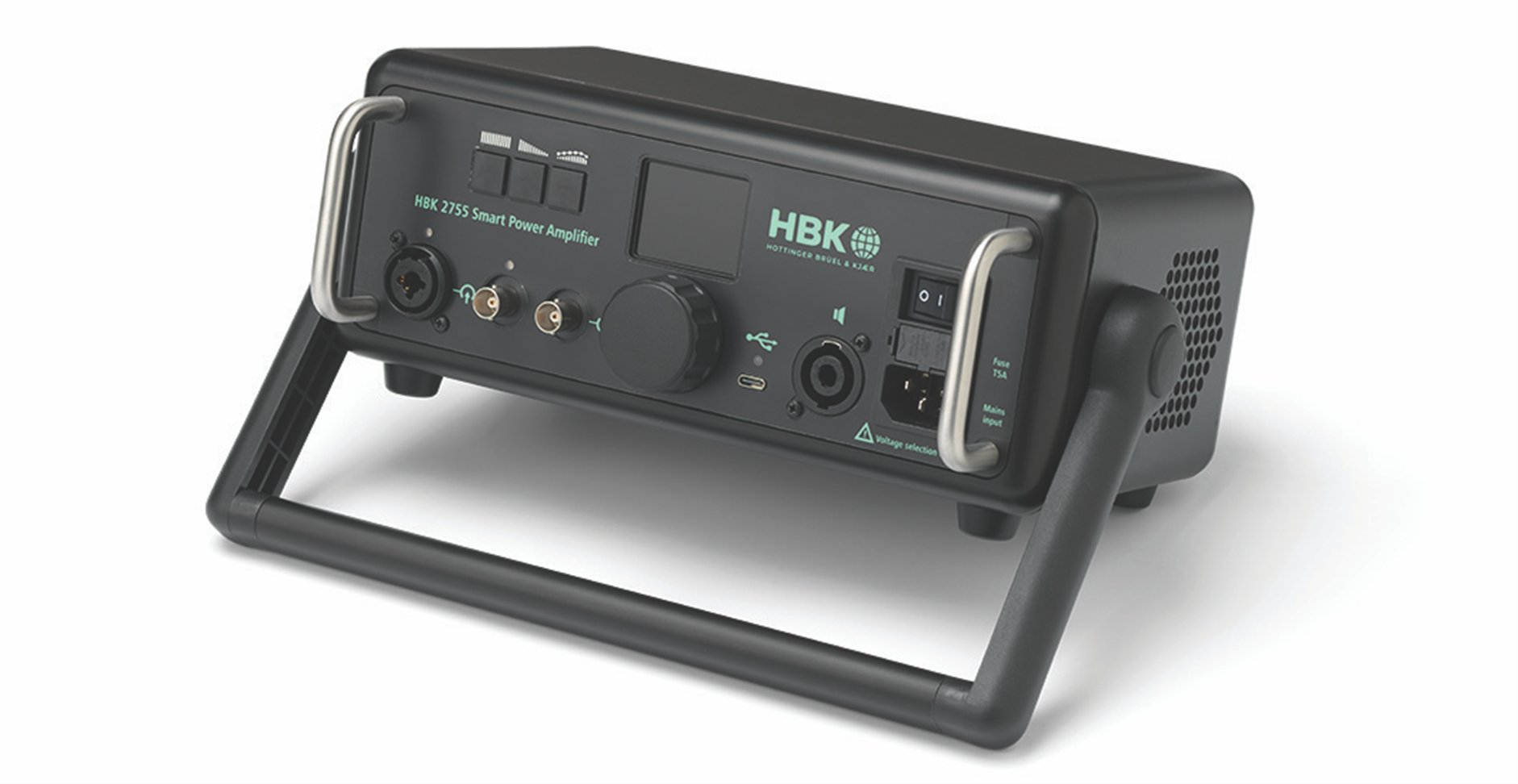
Features
- High-power output, delivering up to 500 W into 4 Ω in bridged mode
- Single- or dual-channel output with optional splitter cable
- Lightweight and highly portable for field use, weighing only 2.2 kg (4.9 lb)
- Powerful signal generator with pre-loaded signals optimized for specific applications
- Designed for multi-application use:
- With OmniPower Omnidirectional Sound Source Type 4292-L with signals optimized for maximum and flat acoustical power for multiple frequency spans
- With HBK volume velocity sources with signals optimized for maximum acoustical power with each extension tube diameter
- Power compression compensation, enabling extremely stable acoustical power output over long periods of continuous operation
- Wireless remote control with HBK 2255 Sound Level Meter and Building Acoustics Partner (Wi-Fi® enabled versions only)
- Wireless remote control from integrated web server (Wi-Fi enabled versions only)
- Can operate as a universal USB audio device, accepting direct connection to phantom-powered or CCLD* microphones and loudspeakers
- Accurate, digitally controlled gain setting with 0.5 dB resolution
Applications
Building Acoustics
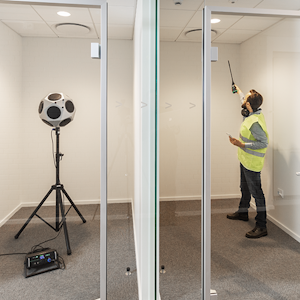
Source Path Contribution
Source path contribution (SPC) analysis is a technique for breaking down the operating noise of a vibro-acoustic system, typically a vehicle,
into contributions from known vibration or acoustic sources. It enables NVH engineers to evaluate the dominant sources and paths contributing
to the sound inside a vehicle while driving, or outside as the vehicle passes by.
An important step in the SPC process is to measure frequency response functions to determine the path sensitivity from various source locations
to the receiver, whether inside or outside the vehicle.
Acoustic transfer functions (sound pressure per unit volume velocity, P/Q) require a volume velocity sensor (VVS) and powerful sound source
over the required frequency range. HBK volume velocity sources are designed for this purpose.
HBK 2755 is designed to provide tailored output to optimize the performance of each VVS.
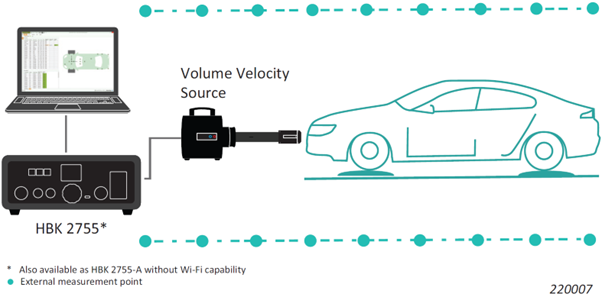
Architectural Acoustics
DIRAC Room Acoustics Software Type 7841 is used for measuring a wide range of room acoustical parameters,
based on the measurement and analysis of impulse responses. HBK 2755 Smart Power Amplifier is designed to work seamlessly with DIRAC,
combining power amplification, microphone conditioning and sound card capabilities into a single, compact and lightweight device.
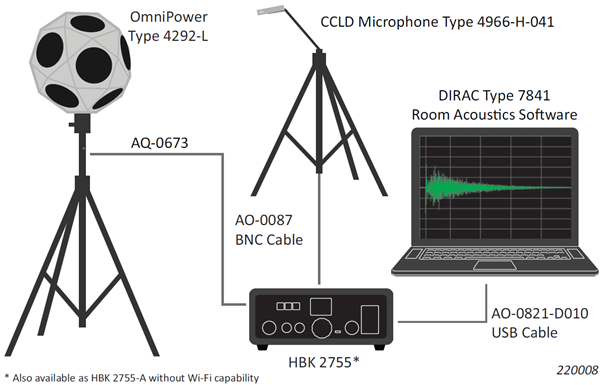
When HBK 2755 is connected to DIRAC over USB, the amplifier can be directly connected to a single CCLD microphone input, or up to two line-level inputs with external conditioning. HBK 2755 can also be used for asynchronous measurements with DIRAC, where the signals are loaded on the amplifier and the microphone inputs from another device.
Specifications
MAXIMUM OUTPUT POWER
(TA = 25°C, 230 VAC/50 Hz, 1 kHz, THD < 10%)
4 Ω: 500 W
6 Ω: 330 W
8 Ω: 250 W
CONTINUOUS OUTPUT POWER (1 kHz, 6 Ω)
With air filter: TA = 25°C: 250 W
Without air filter:
TA = 25°C: 330 W
TA = 35°C: 175 W
INPUT VOLTAGE
Nominal voltage @ Input Gain =
0 dB: 2.0 V
10 dB: 0.63 V
20 dB: 0.20 V
30 dB: 0.063 V
Headroom at nominal input voltage: 17 dB
Common Mode Rejection (1 kHz)
XLR: 80 dB
TRS: 55 dB
Maximum DC Voltage
BNC: -15 to +24 V
XLR: ±15 V
TRS: ±30 V
INPUT CURRENT
(Microphone power supply DC current)
BNC: 4.5 mA
XLR (Max per input): 7 mA
INPUT IMPEDANCE
1kHz, Unpowered:
Balanced: 20 kΩ +0/-2%
Unbalanced: 10 kΩ +0/-2%
DC (Unpowered):
Balanced (XLR): 220 kΩ ±1%
Balanced (TRS): 20 kΩ ±1%
Unbalanced: 10 kΩ ±1%
OUTPUT VOLTAGE
Line Output Peak Voltage: 14.5 V
Power Output Peak Voltage: 32 V
Power Output DC Voltage: 0 V
OUTPUT IMPEDANCE (1kHz)
Line Output: 100 Ω
Line Output load: ≥0 Ω
Power Output: 18 mΩ
Power Output load: ≥ 3 Ω
FREQUENCY RESPONSE (20 Hz - 20 kHz)
Input Gain = Attenuation = 0 dB, from BNC input to:
Line Output: -0.2 dB
Power Output: 0.3 dB
(See also figure below)
SNR (MAX POWER 1kHz)/(SILENCE 0...20 kHz)
Line Output: 100 dB
Power Output: 106 dB
THD+N (20 Hz - 20 kHz)
Input Gain = Attenuation = 0 dB, 1 kHz
Line Output (1 Vrms): -90 dB
Power Output (1 - 450 W, 4 Ω): 1%
GAINS AND ATTENUATION
Input Gains: 0, 10, 20, 30 dB
Input Gain Error (no error @ 0 dB): ±0.1 dB
Attenuation Range: -90 - 0 dB
Attenuation Stepsize: 0.5, 1 dB
Attenuation Error (no error @ 0 dB): ±0.1 dB
Total Gain (Input Gain = Attenuation = 0 dB)
Any Input to:
Line Output: 0 ±0.2 dB
Bridge Mode Power Output: 27 ±1 dB
Single Ended Mode Power Output: 21 ±1 dB
CONNECTORS
Input Sockets:
BNC
Neutrik Combo Jack
XLR 3-pole (balanced)
TRS (1/4" jack, 1 x differential or 2 x single ended)
Output Sockets:
Line Output Socket: BNC
Power (Speaker) Output Socket
Neutrik 4-pole SpeakOn type (1 x bridge or 2 x single ended)>
Mains Power Inlet: IEC type
SIGNAL GENERATOR
Internal Standard Noise Types:
4292-L mode, Freq-Range (1/3-octave bands) and Crest Factor
White: 50 Hz - 5 kHz, 3.5 dB
Pink: 50 Hz - 5 kHz, 3.5 dB
Equalized: (4292-L) 50 Hz - 5 kHz, 3.5 dB
VVS mode, Freq-Range (1/3-octave bands) and Crest Factor
LF, 10 Hz - 1.6 kHz, 12 dB
MF, 20 Hz - 6.3 kHz, 12 dB
HF, 100 Hz - 12.5 kHz, 12 dB
Period Time: 10.9 s
1/3-Octave Spectral Error (4292-L standard noise signals): ±0.35 dB
Line Output Voltage (Attenuation = 0 dB): 1.9 Vrms
Turn off equivalent RT in 1/3-octaves:
< 100 ms @ 50 Hz
< 1 ms @ 5 kHz
LEVEL INDICATOR
Trigger Levels re Power Output Clip Level
Yellow/Red Transition: 0 dB
Green/Yellow Transition: -12 dB
CONTROLS
Generator Buttons (3x): Toggling between On and Off
Attenuation Rotary/Push Knob: Attenuation or Menu
Mains Power Rocker Switch: 2-pole
STATUS INDICATORS
Display (Operational)
Output Level: Single or dual green/yellow/red bar
Attenuation: in dB
Status bar
Attenuation lock
Wi-Fi connection
Amplifier mode
Constant power
Fans
Inputs
Filters
Output
Display (Main Menu)
Presets
Input
Bass/Treble
Output
User Signal
Network
Settings
About
Exit
Full-screen attenuation icons
Attenuation locked
Power stage over-temperature
Power stage over-current/over-load/long-term high frequency
Generator Indicators
4292-L Mode
White noise: White
Pink noise: Pink
Equalized noise: Light-green
User signal: Light-blue
4250 VVS Mode
LF noise: White
MF noise: Pink
HF noise: Light-green
Input Power Indicators
BNC input: IEPE power on: Amber
XLR input: P48 phantom power on: Amber
USB Active LED: Amber
FAN
Turn On Heat Sink Temperature: 55°C
LW at Min Speed: 25 dB re 1 pW
LW at Max Speed: 52 dB re 1 pW
MAINS POWER
Voltage Selector (Rear Panel): 230/115 VAC
Mains Voltage Range:
@ 230 VAC: 200 - 240 VAC
@ 115 VAC: 100 - 125 VAC
Mains Frequency Range: 45-65 Hz
Fuse: Littlefuse T 5 AH 250V 215 series, part #215005.MXP
Maximum Power Consumption: 650 W
Minimum Power Consumption: 15 W
MECHANICAL
Dimensions W x H x D (carry handle folded down):
330 x 130 x 310 mm (13 x 5.1 x 12")
Weight: 2.2 kg (4.9 lb)
Figure 1. 2755 Frequency response
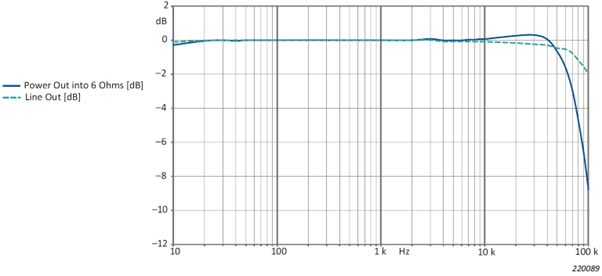
Ordering Information
2755-A-X
Type 7841
Type 4292-L
HBK 2755 Smart Power Amplifier, without Wi-Fi
DIRAC application
OmniPower Omnidirectional Sound Source
Optional Accessories
AO-2030 Splitter Cable, 0.37 m (1.2 ft)
Littlefuse® T 5 AH 250V 215 series fuses (part number 215005.MXP)
Worldwide sales and marketing are handled exclusively by Hottinger Brüel & Kjær. To order the HBK 2755 you must contact your local HBK representative. If you have technical questions regarding the HBK 2755, you may contact us directly.
